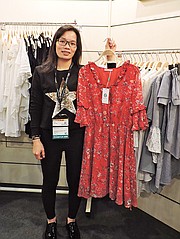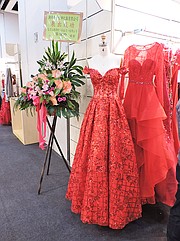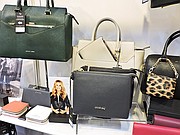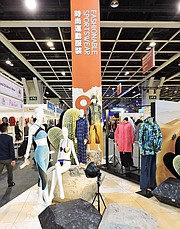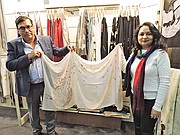TRADE SHOWS
Hong Kong Fashion Week Downsizes to One Hall This Year
HONG KONG—Amidst the endless rows of lacy evening gowns, printed dresses, puffy jackets, ripped blue jeans and fur coats lined up inside the Hong Kong Convention Centre, exhibitors were seeing a shift in buyers.
European buyers were scarcer this year while more retailers and manufacturers were coming from Malaysia, Myanmar, the Middle East and Australia, exhibitors said.
The shift in buyers comes as European retailers are transferring their sourcing to other countries such as Vietnam and Indonesia. For some time, U.S. buyers have been a rare commodity as Chinese wages have risen by double-digit percentages in recent years.
But the decades-old show still attracts a number of steady U.S. production and sourcing managers, such as Noelle Erspamer and Morgan Davis, who work for Star of India Fashion Co. in Arizona.
The two have been attending the show for at least a decade to find new suppliers and meet current factories producing their bohemian-style womenswear made under the Angie label. “This is a one-stop shop,” Davis said.
This season they were looking for knitwear, prints and artwork for the company’s Fall/Winter 2018 season.
As they wandered through the booths, they were surprised to see the show seemed to have shrunk. Last year, the January show occupied two huge convention-center halls. This year, it filled only one hall. “The show is half of what it used to be,” Erspamer said.
At the recent show, which ran Jan. 15–18, there were nearly 1,400 booths in the Fall/Winter 2018 edition of the exhibit. Last year, there were 1,515 booths. In past years, the show included a World Boutique section, which highlighted about 250 designers and brands. That was moved a few years ago to a September exhibit called Centrestage,
which focuses more on fashion collections and has numerous runway shows.
Organizers admit that China is not producing as much clothing as it used to nearly 20 years ago when it became a popular sourcing area after it joined the World Trade Organization in late 2001. Chinese and Hong Kong vendors have always made up nearly 90 percent of the exhibitors.
But with many sourcing agents shifting their production to lower-cost countries such as Vietnam, Bangladesh and India, fewer Chinese vendors are participating in the show. “The trouble is that retail customers want lower costs,” said Lawrence Leung, chairman of the Garment Advisory Committee to the Hong Kong Trade Development Council. He is also the managing director of Sun Hing Knitting Factory Ltd.
At one time, he had three knitting factories that made sweaters in China. Now he has one factory, which still does high-end sweaters that aren’t necessarily being produced in countries with lower wages.
To keep the show fresh, organizers added a new exhibit section for fashion uniforms and fashion accessories as the service-industry world increases its demand for crisp uniforms. “This is a big industry,” Leung said, counting off the number of commercial sectors such as hotels, restaurants, retailers and airlines that require their workers have uniforms. “Each person has to have two to three sets of uniforms. No country dominates this.”
Marketing opportunity
Hong Kong Fashion Week has always been a place where businesses try to expand their reach to find new customers or launch new brands or manufacturing options.
That was the case for Innée-Sedona International Ltd., a Hong Kong company that has partnered with the Bugatti Group and Global Licensing in Canada to produce and distribute various fashion items with the Céline Dion brand attached to them.
The new label debuted last February at the Las Vegas trade shows, but now the group is introducing the singer’s collection of handbags and luggage to mostly the Asian market and Australia, said Gary Gardner, a director with the Bugatti Group.
The music-inspired handbags and luggage are targeting the luxury market that falls somewhere between Michael Kors and Coach, Gardner said. High-end leather purses retail for $250 to $500, and the luxury line goes for $385 to $800 while a more affordable collection made of PU leather retails for $68 to $200.
“The reaction to the label has been very good,” said Jennifer Chan, managing director for Innée-Sedona International. “We have a Chinese group that wants to open stores in China and invest in the market in Hong Kong.”
Eventually, Céline Dion wants to expand into fashion, cosmetics and a home collection, Gardner said.
New business was the reason that Plume Nova, a small company in Jaipur, India, that makes scarves and shawls, made this their second visit to the show. “We started to feel like we were not able to expand remaining in India,” said Anuj Khandelwal, who started the 16-year-old company with his wife, Vinita.
He said they branched out to the international market two years ago to sell their pashmina and wool scarves and shawls, which are hand embroidered by 450 workers in their factory.
At the Hong Kong show, they were seeing mostly buyers from Thailand, Malaysia, Myanmar and a smattering from the United States.
May Lu, whose father started the Guangmei Garment Co. more than a decade ago, said her family had heard that the Hong Kong show was a good place to meet new customers. By the third day, she had seen 20 buyers—mostly from the Netherlands, Australia and England—who were interested in getting samples of the womenswear the company made outside of Guangzhou. “People are looking at styles and choosing samples to be made,” she said.
First-time exhibitor Shanghai Joyfly Import & Export Co. was one of the vendors inside the new uniform section. The company makes school uniforms for customers in Australia and New Zealand, but company directors were hoping to expand to new territory. “We haven’t seen too many buyers from the United States, but there are a lot from Asia,” said Xu Jiajun, general manager.


